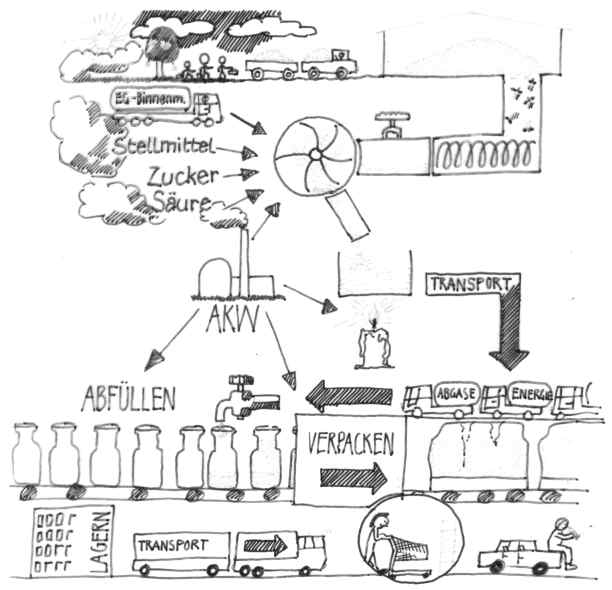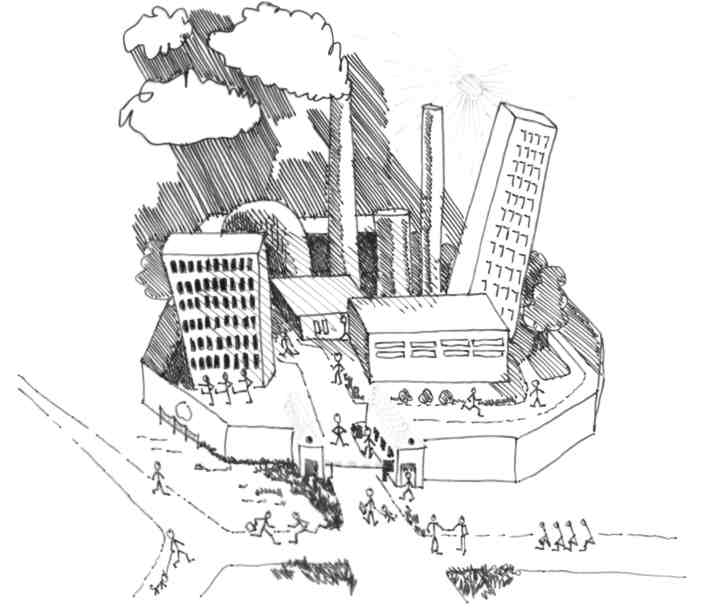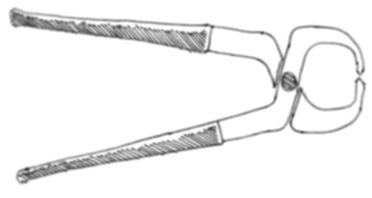LIVING WITH POISON |
 |
This is a story about the effects of toxic substances.
Chemical substances, which we don't want in our body are called toxic. Our body itself is made of chemical substances and its survival depends on many different substances. At first this sounds very confusing, because there are so many substances in our environment. There are a few among them whose effects are not desirable for us. For that reason the development of our biology has given us many tricks to protect us from unwanted chemical substances and their effects. |
 |
The science of poisons, toxicology, is unfortunately not easy to understand.
This is not because of the complicated topic, but because of the history
of toxicology, which was mystified by magic at the times of alchemy. Later
on it was a subsidiary subject of pharmacology and because of the medical
phrases not very comprehensible.
This text was developed for the instruction and further education of the fire brigade and the internal education of industrial workers, who handle dangerous chemicals. |
 |
From the idea of ecosystems I developed an easy model that might make
the science of poisons comprehensible:
I compare the poisons invading the ecosystem man with foreign substances that invade a different complex system. Such systems are for example a production plant, a hospital, a school or a fire station. The consideration/analysis/in-depth-look is divided in four parts: 1. How does an organism protect itself
from the invasion of unwanted substances ?
|
 |
This text is a parallel story, which I present with suitable objects
and transparencies.
In the text the parallels are marked by different colours. The comparisons are often not perfect in style and formulation. Uwe Hillman made the drawings for the text. They often form series of drawings that are more exciting to watch with an overhead projector than in the text. As a reader you have to picture yourself a lecture! This text is meant to be a mnemonic aid, to have a better recollection of the lecture. The special effects of single substance groups are only briefly mentioned in the lecture to maintain an overview over the whole field of toxicologists. For details you can use numerous books (for example Max Daunderer). |
| Here begins our story about LIVING WITH POISON
Read the text once with the red colour and a second time with the green colour. A presentation of the effects of an the protection from toxic substances, which is explained by an example of unwanted foreign substances for man : take a look in the mirror,
you have a skin for protection, a mouth to take up substances with, an
organic interior and a biological, integrated defense system.
|
 |
| Part One : The boundary
The organism has a boundary that separates him from the outside world. He uses it to protect himself against everything that may invade him from the outside. With the skin / the factory fence all usual things, that shall not enter the organism, are averted. The experience that has been made up to now, namely the biological evolution / a trained architect has structured the boundary in a way that enables it to fulfil its task with the least possible expense. |
 |
| 1. The stability
In some spots the demand on the boundary is extremely high, therefore the structure is stronger: horny skin, fingernails crash barrier, stronger fence, higher fence 2. Injury In some cases the stability of the boundary is not strong enough for unusual influences, an injury is possible: a cut from a knife / pincers make holes |
 |
| 3. Repair
The organism has to initiate repair activities. We will come back to that in Part Four: erythema (reddened skin) indicates better
blood circulation, pus is secreted
Fast, temporary protection helps remove the wound: plaster / barriers |
 |
| Possible invaders, like
bacteria, dirt / walkers, troublemakers can be rejected at the same time. |
 |
| 4. Maintenance
With such a boundary problems come along: skin can age, dry out and tear
Constant care helps prevent problems and small parts of the boundary are replaced regularly. |
 |
| 5. Defenseless
Problems also exist with substances, things or objects that cross the boundary without leaving noticeable wounds. Many chemicals are resorbed by the skin.
Petrol, aromatic hydrocarbons, alcohol, pesticides, ... are marked with
the symbol for danger "h" meaning skin resorbtive.
6. Short time reinforcements If it is known, which unusual stresses are to be expected for the boundary of the organism, additional protection can be put up. The additional protection is determined by the experiences the organism has made until now. These experiences can misjudge the danger: the protection is overestimated or too weak. gloves against the cold, slop, chemicals,
heat
|
 |
|
Part Two : Mass transfer The boundary protects the organism, but it has to take part in the life surrounding it, it is inevitably ecologically connected with other organisms. Therefore the boundary is specifically pervious. Special installations supervise the exchange: The mouth is protected by the senses. If
we bring a substance in the vicinity of the mouth, the sense of touch transfers
information, the eyes evaluate it, the nose with its sense of smell will,
immediately in front of the mouth, report if the substance smells suspicious.
The contact with the lips, the feeling we have while chewing, the control
of the taste, all is made use of and the information is collected, correlated
and judged.
If an invading substance awakens suspicions, there are certain countermeasures: the mouth closes, the breathing stops / the door is shut The control at the passage points is problematic in five cases: |
 |
| 1. The unwanted substance goes by unnoticed.
carbon monoxide is odourless
2. The unwanted substance disguises itself as, is confused with customary substances. lead carbonate tastes like sugar, hydrocyanic
acid smells like bitter almonds.
3. Unfamiliar substances arrive in large amounts and too quick. a cloud of methylisocyanate, toxic smoke
|
 |
| 4. The unfamiliar substance hides in a large amount of known substances.
fishbones, cherry stones or mushroom poisoning
often go by unnoticed with other food.
5. The protective functions are paralyzed Pain, a cold, heavy smoking or alcohol deaden
the senses.
|
 |
| Part Three: Interior effects
Now it happened, the foreign, unwanted substances invaded the organism. Six different results will be looked at: 1. Harmless substances The substances don't disturb the interior, they are unnoticed, don't cause any damage and leave the interior at a favorable moment, without calling any attention to them. single cherry stones, sand, placebos
|
 |
| The harmless substances will cause problems, if their number grows
too large. Then we become aware of them:
eating many cherry stones
|
 |
| 2. General chaos
Some foreign substances cause unspecific damage. The organism
notices that something is wrong, but the usual activity is not disturbed.
feeling uncomfortable, insomnia, indigestion,
the cardivascular system is not at maximum capacity, lack of concentration.
Only when productivity rises will the organism start to collapse, because now the small disturbances show their effects: |
 |
| In cases of stress or too much work the reduced
resistance is displayed.
In cases of deadlines or alarms small defects cause bigger accidents and shut down the activity. If we notice, that our organism can't handle the unspecific damages caused by additional loads, then we can: Take a cure and clean up our interior. With
medical care we can regenerate our health as far as possible.
Unspecifically acting foreign substances can still harm the organism if they enter in large amounts. radioactive radiation or city air
|
 |
| 3. Specific poisons
Substances in the organism might also have very specific effects. Specialist only need a minimal concentration to find the right switch and harm the organism. lead blocks enzymes, phosgene works as war
gas, the arrow poison curare or the extremely poisonous dioxins are very
specific
|
 |
| We know several different mechanisms of impairment. Here are two of
them:
The foreign substance blocks the transport systems: carbon monoxide, cyanide or sulfur hydrogen react
with haemoglobin in the blood cells and block the oxygen transportation,
respiration will cease.
|
 |
 |
The foreign substances are mistaken for substances that belong to the
organism, but they can't satisfy the demanded functions. The organism is
no longer viable.
compounds of barium are chemically similar
to compounds of calcium, but they can't take over their functions, for
example when transporting of nerve signals (for that reason soluble barium
compounds are used as rat poison).
|
 |
4. Chronic effects
Until now, we have looked at effects that can be recognized very soon. Beside acute poisonings there are also the chronic poisonings. If we absorb foreign substances in small amounts and they gather in the organism (accumulation), they suddenly, after a waiting (latency) period or an extreme physical demand, become effective. The organism gets visibly sick. PCB accumulates in body fat, cadmium in
the kidney. Other chronic poisonings show their effect only after a long
time, like arsenic (18 years) or cadmium (30 years).
|
 |
5. Synergies
When several different foreign substances have invaded the organism synergies can occur. In that case the effect of those substances is worse than the sum of the single effects would be. Synergies are disastrous, because there is little research concerning them and the threshold values for toxic substances are gained from the effects the substance has on a healthy organism that is not harmed by other poisons. Research has been done with miners of the Johannistalgruben
to test the effect of radioactivity and tobacco smoking
|
 |
6. Accompanying substances
Substances whose toxic effects are known can be neutralized if they are escorted by other substances. Through the socialisation of certain substances who always appear at the same time, the harmful effect of these substances will be eased. In our diet many problem substances exist,
that are used as flavour or as basic substances (like sugar). However there
are also many accompanying substances that neutralize the harmful effects.
Joined with vitamins and enzymes the effects of sugar are unproblematic,
as single substance its effects can be "toxic".
|
 |
Part Four: Defense systems
Organisms have gathered experiences concerning and adjusted to the appearance of foreign substances causing damage in their interior. Learning by experience (trial and error) is the same for architects as it is for evolution. Two important mechanisms are available to the organisms. The immune system and redundancy. |
 |
1. The immune system
The immune system is supposed to resist intruding substances. It has been developed by evolution and is available at birth. White blood corpuscles defend against bacteria infections in a wound. Vaccinations can increase the existing immune
system.
|
 |
A defense system can sometimes be overburdened. It can't repair the
damage with its own means, help arrives from the outside:
When we have large scale burnings or several
infections at once we are given drugs (antibiotics).
Outside help can be very effective, but often side effects that harm the organism occur: Acetylsalizilacid helps against headaches
but damages the stomach lining.
|
| While the immune system is working, the activity of the organism is
often decreased. Parts of the organism are shut down or managed at reduced
activity. After the damage is repaired the organism needs a certain time
to regain its usual fitness.
During a sickness we lie in bed quietly,
afterwards we need time to regenerate, rehabilitate or take a cure.
The defense system can become ineffective or break down. Outside help is needed to replace the immune system, but there are problems with possible side effects. In case of leukemia or HIV drugs can help
prevent infections for a while.
|
 |
| The defense system can also act up. It repairs damages, where none
exist and gets everything mixed up. The last chance then is to paralyze
the whole immune system. For the reconstruction outside help is necessary:
An allergic reaction is a mistake, which
for example reddens the skin at an uncritical, not endangered spot. The
skin is supplied with a lot of blood and signals (itches) report a bad
wound. Because in reality there is no wound, this mistake is very annoying.
|
 |
| 2. Redundancy
The second important mechanism that is used by an organism to
protect itself against damages is that some functions are multiple or have
more capacity than they normally need (redundancy).
The pulmonary volume, the kidney capacity, the
liver size, the amount of blood, ... are proportioned very generously.
If through sickness (for example scar tissue in the lungs or tar from cigarettes)
parts of this extra capacity are blocked, we don't notice anything. Not
until further damage is done, which can be relatively small, and exhausts
all reserves we become aware of an enormous damage.
Extra capacity can be useful for the organism, but it makes our usual cause-effect-analysis difficult, when we are searching for toxic substances that are responsible for a visible damage. |
 |
| Epilogue
The story about the effects of toxic substances surely has to
be enlivened with examples and experiences from the listeners. Still the
story is a strong simplification and the examples should not pretend to
be an argumentation.
|
 |